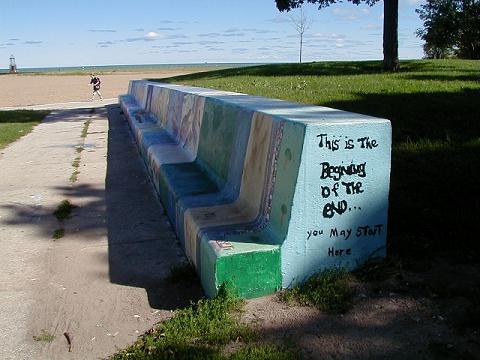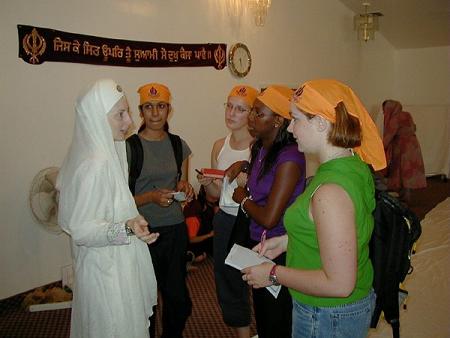| Site Visits and Epistemological Diversity in the Study of Religion |
![PDF-NOTE: Internet Explorer Users, right click the PDF Icon and choose [save target as] if you are experiencing problems with clicking.](http://rsnonline.org/templates/rsntemplate-smallmasthead/images/pdf_button.png) |
 |
Jeffrey Carlson, Dominican University
In some curricula, “diversity” or “multiculturalism” is relegated to a single course on the so-called non-Western or “minority” communities in the United States. I would argue that a central and abiding curricular goal should be to move from episodic moments of diversity within the curriculum to an epistemology of diversity across the curriculum, wherein our challenge is to engage multiple perspectives (cultural, national, religious, ideological, methodological, etc.) in our courses and curricular design, and to develop effective strategies for teaching a diverse curriculum within a diverse learning community. Using site visits in the study of religion can become an important means of achieving this goal. One context in which I have used site visits is a course I taught several times at DePaul University that began with a one-week “immersion” immediately preceding the official start of the academic term. The course was called “Sacred Spaces, Powerful Places.” It asked how is it that some physical locations have deeper meanings than others — becoming symbolically powerful, sometimes “sacred,” in persons’ experiences? Who comes to these spaces/places, who does not, and why? To explore these questions, we visited an array of places, including the Chicago Historical Society, the Indo-American Cultural Center, the Sousa Homeless Shelter, St. Sabina Catholic Church, the Cook County Department of Corrections, Division 10 (maximum security), the Baha’i House of Worship, Gillson Park, the Federal Reserve Bank of Chicago, a farmers market in the Richard J. Daley Center Plaza, the Chicago Board of Trade, the Chicago Loop Synagogue, and the North Park Village Nature Center. We reflected on the importance of place in a time of rootlessness, the role of memory and ritual, pilgrimage and worship, the stories of immigrants and the dispossessed, our craving for nature, the role of public spaces, and a host of other ways that people experience places as particularly significant. Each day of this immersion week, we began early in the classroom, explored sites in Chicago, and returned to the classroom in the early evening. It is particularly important in such a course to devise strategies for relating classroom discussions and readings to the site visits. Too often when we employ site visits in the study of religion, the danger is that the “experiential” is not brought into intentional and explicit relation with the “traditional” classroom work and reading. Disconnected “field trips” can become moments of hiatus from the course, rather than an expression of it (not unlike films shown in class, which may allow students to tune out). Ironically, many of our “experiential” courses may, in fact, exacerbate unwittingly the bifurcation between the classroom and the so-called “real world” — a bifurcation the instructor presumably hopes to overcome precisely by incorporating site visits. Students and faculty may have rich and rewarding experiences outside the classroom, but what, after all, do they have to do with the readings? Thus, it is imperative that we devise specific methods for bringing these realities into intentional, sustained, and mutually critical dialogue. Two principal methods have been effective in my own practice: first, to use prompts from yet-to-be-read texts prior to site visits; and second, to have students take digital photos at the sites, so that these can be revisited later and “reread” through the lenses of the course texts. In Terms of the PromptsAfter the immersion week for “Sacred Spaces, Powerful Places,” students read, among other things, Winifred Gallagher’s book The Power of Place: How Our Surroundings Shape Our Thoughts, Emotions, and Actions. In a classroom session before departure to a site, I presented students with brief introductions to some of Gallagher’s ideas, such as the importance of “nature” in contemporary urbanized society, and the importance of territorial symbols and “personal space.” Then, when students entered some of the sites mentioned above, or others I had used in previous years, such as the Lincoln Park Zoo, Graceland Cemetery, the Gurdwara Sahib of Chicago, the Harvey Islamic Center, or Niketown Chicago, they had some conceptual tools to bring into dialogue with their experiences. Other “preunderstanding” prompts were selected and introduced from other readings, such as Mircea Eliade’s The Sacred and the Profane: The Nature of Religion; Yi-Fu Tuan’s Topophilia: A Study of Environmental Perception, Attitudes, and Values; and Lucy R. Lippard’s The Lure of the Local: Senses of Place in a Multicentered Society. Tuan’s book raises questions about perception, scale, segmentation, spatial ethnocentrism, maps and power, visitor vs. native, explorer vs. settler, a critique of tourism, the relation of the visual to aesthetic distancing, dynamics of city/countryside/wilderness, the relation of notions of afterlife to environmental ideals, the vertical cosmos vs. horizontal landscapes, and the changing meanings over time of “nature,” “landscape” and “scenery.” Lippard’s book explores, among others, notions of multicenteredness, displacement, gendered landscapes, immigration, hybridity, assimilation, deterritorialization, maps, the commodification of history, museums and decontextualization, feminist archaeology, homelessness, theme towns, recreational apartheid, urban vs. suburban parks, and yard art.
In Terms of the PhotosAt site visits, students took digital photos in order to attain a literal and metaphorical snapshot of significant facets of the experiences. I asked them to take photos of a person, place, object, or event they deemed worth noting at the time and, perhaps, worth remembering later. What makes one of these examples worth noting? In part, if it exemplifies, challenges, or extends some of the textual concepts already introduced, as well as the students’ own preunderstandings, some of which had also been voiced in class. At the end of each long day during the immersion week, these photos were loaded on a course Web site. Weeks later in the term, when we read books and discussed them in class, we revisited the photos and our field notes taken throughout the immersion week. In this way students interpreted the readings, at least in part, through the site visits, although we did not allow our photos, selective memories, and reconstructions of the site visits to dominate our “readings” of the texts.
I have shared one worry about site visits already; namely, that they might exacerbate the bifurcation between the classroom and the so-called real world. Site visits might also embolden students to articulate negative stereotypes of the community they visit. Some non-Muslim students who, for example, have never been to a mosque might resist voicing anti-Muslim views, reasoning that “since I’ve never been there, I cannot comment.” Then they take a religion course somewhere, go to a mosque on a field trip, and have what they consider to be a “bad experience,” which reinforces their preexisting stereotype. Now, since they have in their own minds attained a kind of “credential,” they may feel unconstrained in voicing their previous stereotypes. In one sense, the limited, single-week “immersion” course I have been describing is particularly prone to this pitfall. One strategy to counter this negative potential is to anticipate and address potential negative stereotypes about the sites before visiting them. Another strategy could be to visit multiple sites from the same tradition, and/or the same site multiple times. Let me illustrate this in relation to another variation of this “single visit” problem. A frequent scenario is the uncritical, romantic “yes” students sometimes express when they visit a site for the first time. Once my class and I visited a Japanese Zen center. Most of the students were enamored with “the mystical East,” speaking openly about the profound “spiritual presence” they felt they encountered. However, on the walk to the elevated train to take us back to campus, two of the students were shaking their heads, grumbling among themselves. I asked these two recent immigrants from Vietnam why they were so troubled, and they replied, “That’s not real Buddhism.” As we talked, a possibility emerged: Later in the week we would be nearby another temple, one these two students themselves frequented. They knew the monk personally and volunteered to contact him and to arrange for us to visit. It meant shifting a few things and having a shorter lunch break/discussion time that day, but we went. It was indeed a very different experience than our earlier one at the Zen center. The class came to appreciate the diversity of “Buddhism.” Furthermore, they realized that two sites did not exhaust this diversity. The two Buddhist students helped teach and exemplify, again, an epistemology of diversity wherein multiple perspectives might be discerned and engaged, even as these two students experienced in a new way the diversity of their own tradition. As Jonathan Z. Smith has put it, in the classroom, “nothing must stand alone....[E]very item encountered...[must] have a conversation partner, so that each may have, or be made to have, an argument with another in order that students may negotiate difference, evaluate, compare, and make judgments” (Smith 1988, 735). The same holds true for courses using site visits. Integration of site visits in the study of religion can foster and exemplify an epistemology of diversity, wherein the critical and integrative thinker is one who learns enough to be able to consider multiple views, multiple approaches to a problem, and multiple applications of a theory or concept; to adjudicate between them in a deliberate and reflective manner; and to develop a coherent, informed, and ethically responsible vision. ReferencesSmith, Jonathan Z. “‘Narratives into Problems’: The College Introductory Course and the Study of Religion.” Journal of the American Academy of Religion 56 (1988): 727–739. |


 Jeffrey Carlson is Dean of the Rosary College of Arts and Sciences and Professor of Theology at Dominican University in River Forest, Illinois. He is co-author of Jesus and Faith: A Conversation on the Work of John Dominic Crossan (Orbis Books, 1994) and has published on religious pluralism and teaching and learning in higher education.
Jeffrey Carlson is Dean of the Rosary College of Arts and Sciences and Professor of Theology at Dominican University in River Forest, Illinois. He is co-author of Jesus and Faith: A Conversation on the Work of John Dominic Crossan (Orbis Books, 1994) and has published on religious pluralism and teaching and learning in higher education. By providing prompts that introduce some of these concepts in the morning classroom time, during breaks in the day, and in the evening classroom session, I hoped to enable students to interpret the site visits, at least in part, through the readings they would consider in-depth later in the course. The bifurcation between text and experience was, I hope, lessened, and the experiences themselves deepened. We did not, however, allow these textual concepts to dominate our “readings” of the sites, and as a class we generated our own questions and observations. These observations were brought into an intentional dialogue with ideas from the texts we read. The resulting multiplicity of possible interpretations was itself an explicit manifestation of an epistemology of diversity.
By providing prompts that introduce some of these concepts in the morning classroom time, during breaks in the day, and in the evening classroom session, I hoped to enable students to interpret the site visits, at least in part, through the readings they would consider in-depth later in the course. The bifurcation between text and experience was, I hope, lessened, and the experiences themselves deepened. We did not, however, allow these textual concepts to dominate our “readings” of the sites, and as a class we generated our own questions and observations. These observations were brought into an intentional dialogue with ideas from the texts we read. The resulting multiplicity of possible interpretations was itself an explicit manifestation of an epistemology of diversity. One concrete way of using the photos is as the basis of more formal writing assignments. In such an assignment, students might be asked to (a) identify a theme about place from one of the books; (b) explain how the author might illustrate this particular theme through a concrete aspect of the immersion week, using at least one photograph from the week to aid in the student’s analysis; and (c) develop and defend the student’s own position on the specific theme under consideration, again, using a site photograph. Another similar assignment might ask students to imagine how Eliade, Tuan, Gallagher, and Lippard would engage in a dialogue with each other about the meaning of a site, again via the person, place, object, or event depicted in a particular photograph. Through these assignments, students learn to interrogate the “real world” through texts, and to interrogate texts through the “real world.” Site visits embody an epistemology of diversity and foster an enquiring habit of mind and heart worthy of the liberal and lifelong learner.
One concrete way of using the photos is as the basis of more formal writing assignments. In such an assignment, students might be asked to (a) identify a theme about place from one of the books; (b) explain how the author might illustrate this particular theme through a concrete aspect of the immersion week, using at least one photograph from the week to aid in the student’s analysis; and (c) develop and defend the student’s own position on the specific theme under consideration, again, using a site photograph. Another similar assignment might ask students to imagine how Eliade, Tuan, Gallagher, and Lippard would engage in a dialogue with each other about the meaning of a site, again via the person, place, object, or event depicted in a particular photograph. Through these assignments, students learn to interrogate the “real world” through texts, and to interrogate texts through the “real world.” Site visits embody an epistemology of diversity and foster an enquiring habit of mind and heart worthy of the liberal and lifelong learner.